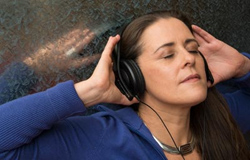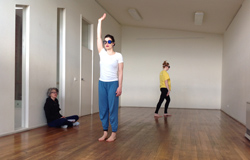2014 Synapse Residency Program
Synapse, an initiative of the Australia Council for the Arts and ANAT, supports collaborations between artists and scientists
The following Australian artists have been awarded Synapse residencies for 2014:
Jane Baker + the Wicking Dementia Research and Education Centre, University of Tasmania
 Tasmanian sound artist Jane Baker will work with researchers at the Wicking Centre on a project exploring the psychological and physiological benefits of introducing virtual biophonic (biological, non-human sounds) and geophonic (non-biological sound of the natural environment) soundscapes to aged-care residents living in environments dominated by human sound. The partners will also explore the concept of ‘era appropriate’ reminicence soundscapes in order to develop user-friendly interactive sound modules for high-needs dementia patients as a way of promoting self-calming and subjective coherence.
Tasmanian sound artist Jane Baker will work with researchers at the Wicking Centre on a project exploring the psychological and physiological benefits of introducing virtual biophonic (biological, non-human sounds) and geophonic (non-biological sound of the natural environment) soundscapes to aged-care residents living in environments dominated by human sound. The partners will also explore the concept of ‘era appropriate’ reminicence soundscapes in order to develop user-friendly interactive sound modules for high-needs dementia patients as a way of promoting self-calming and subjective coherence.
Image: Jane Baker
Shelley Lasica + the Centre for Eye Research, University of Melbourne
 Choreographer Shelley Lasica will work alongside clinical researchers to explore how spatial and proprioceptive awareness functions in the enjoyment of dance for performers and audiences alike. Working with both sighted and vision-impaired participants at the junction between contemporary dance and scientific enquiry, the project will contribute to research into how deteriorating vision impacts the remaining senses – in particular through an investigation into the ways that compensatory adjustments made by the non-visual senses support movement and ‘placement in space’.
Choreographer Shelley Lasica will work alongside clinical researchers to explore how spatial and proprioceptive awareness functions in the enjoyment of dance for performers and audiences alike. Working with both sighted and vision-impaired participants at the junction between contemporary dance and scientific enquiry, the project will contribute to research into how deteriorating vision impacts the remaining senses – in particular through an investigation into the ways that compensatory adjustments made by the non-visual senses support movement and ‘placement in space’.
http://lasica2014.blog.anat.org.au
Image: Choreographer Shelley Lasica works with dancers during her Synapse residency
Cat Jones + the School of Medicine and Pharmacology, University of Western Australia
Building on her recent research into plant signalling and adaptive behaviours, performance artist Cat Jones will work alongside leading neuroscientists concerned with brain plasticity, perception, the remapping of synapses and cortical reorganisation. The partners seek to expand non-pharmacological techniques for the management of chronic pain and are especially interested in testing how creatively-derived augmented reality might be used as a therapeutic tool for core body pain. Alongside this, Jones will research the evaluation, ethics and risks associated with using such tools and techniques in performative contexts.
http://jones2014.blog.anat.org.au
Image: Cat Jones’ Somatic Drifts
Leah Barclay + the Australian Rivers Institute, Griffith University
Furthering Leah Barclay’s long-term engagement with soundscape ecology and bioacoustics, she will partner with the Australian Rivers Institute to explore new methods for acoustically monitoring three Queensland river systems: the Brisbane River, the Mary River and the Noosa River. Listening labs will be established on each of the rivers to experiment with hydrophonic recording and sound diffusion to measure aquatic biodiversity including fresh-water fish populations – a key indicator of river health. The residency will also explore models for community engagement, the creative possibilities of aquatic bioacoustics and the potential for new approaches to the management and conservation of Australian river systems.
http://barclay2014.blog.anat.org.au
Image: Dr Toby Gifford recording on the Brisbane River. Photo: Simon Linke






